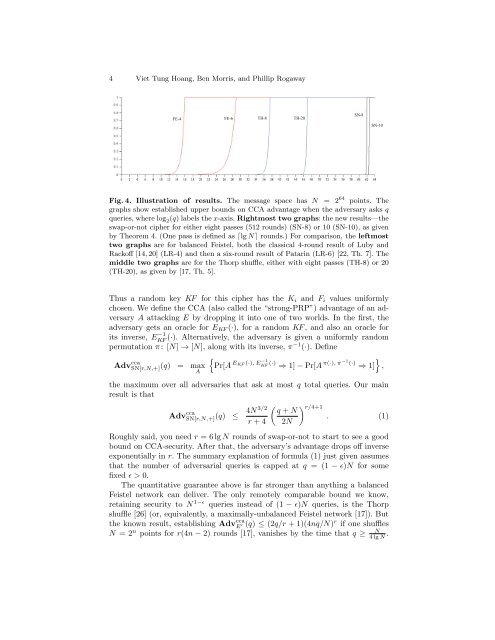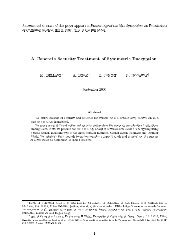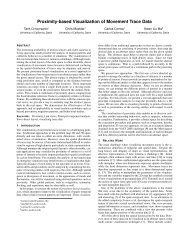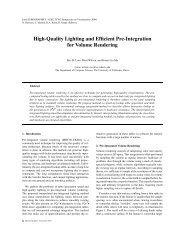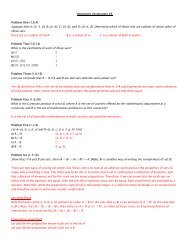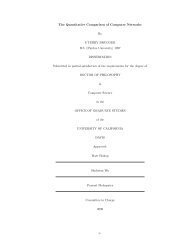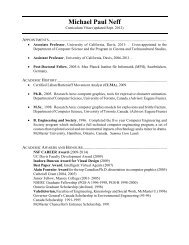An Enciphering Scheme Based on a Card Shuffle - Department of ...
An Enciphering Scheme Based on a Card Shuffle - Department of ...
An Enciphering Scheme Based on a Card Shuffle - Department of ...
You also want an ePaper? Increase the reach of your titles
YUMPU automatically turns print PDFs into web optimized ePapers that Google loves.
4 Viet Tung Hoang, Ben Morris, and Phillip Rogaway<br />
FE-4 FE-6 TH-8 TH-20<br />
Fig. 4. Illustrati<strong>on</strong> <strong>of</strong> results. The message space has N = 2 64 points. The<br />
graphs show established upper bounds <strong>on</strong> CCA advantage when the adversary asks q<br />
queries, where log 2(q) labelsthex-axis. Rightmost two graphs: the new results—the<br />
swap-or-not cipher for either eight passes (512 rounds) (SN-8) or 10 (SN-10), as given<br />
by Theorem 4. (One pass is defined as ⌈lg N⌉ rounds.) For comparis<strong>on</strong>, the leftmost<br />
two graphs are for balanced Feistel, both the classical 4-round result <strong>of</strong> Luby and<br />
Rack<strong>of</strong>f [14, 20] (LR-4) and then a six-round result <strong>of</strong> Patarin (LR-6) [22, Th. 7]. The<br />
middle two graphs are for the Thorp shuffle, either with eight passes (TH-8) or 20<br />
(TH-20), as given by [17, Th. 5].<br />
Thus a random key KF for this cipher has the Ki and Fi values uniformly<br />
chosen. We define the CCA (also called the “str<strong>on</strong>g-PRP”) advantage <strong>of</strong> an adversary<br />
A attacking E by dropping it into <strong>on</strong>e <strong>of</strong> two worlds. In the first, the<br />
adversary gets an oracle for EKF (·), for a random KF , and also an oracle for<br />
its inverse, E −1<br />
(·). Alternatively, the adversary is given a uniformly random<br />
KF<br />
permutati<strong>on</strong> π :[N] → [N], al<strong>on</strong>g with its inverse, π −1 (·). Define<br />
Adv cca<br />
SN[r,N,+](q) = max<br />
A<br />
SN-8<br />
<br />
EKF (·), E−1<br />
Pr[A KF (·) ⇒ 1] − Pr[A π(·), π−1 (·)<br />
⇒ 1]<br />
the maximum over all adversaries that ask at most q total queries. Our main<br />
result is that<br />
Adv cca<br />
3/2<br />
r/4+1<br />
4N q + N<br />
SN[r,N,+](q) ≤ . (1)<br />
r +4 2N<br />
Roughly said, you need r =6lgNrounds <strong>of</strong> swap-or-not to start to see a good<br />
bound <strong>on</strong> CCA-security. After that, the adversary’s advantage drops <strong>of</strong>f inverse<br />
exp<strong>on</strong>entially in r. The summary explanati<strong>on</strong> <strong>of</strong> formula (1) just given assumes<br />
that the number <strong>of</strong> adversarial queries is capped at q = (1 − ɛ)N for some<br />
fixed ɛ>0.<br />
The quantitative guarantee above is far str<strong>on</strong>ger than anything a balanced<br />
Feistel network can deliver. The <strong>on</strong>ly remotely comparable bound we know,<br />
retaining security to N 1−ɛ queries instead <strong>of</strong> (1 − ɛ)N queries, is the Thorp<br />
shuffle [26] (or, equivalently, a maximally-unbalanced Feistel network [17]). But<br />
the known result, establishing Adv cca<br />
E ′ (q) ≤ (2q/r + 1)(4nq/N)r if <strong>on</strong>e shuffles<br />
N =2n points for r(4n − 2) rounds [17], vanishes by the time that q ≥ N<br />
4lgN .<br />
SN-10<br />
<br />
,


